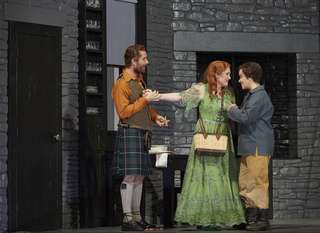|
Back
Handel’s Scottish Opera Toronto
The Four Seasons Centre for the Performing Arts
10/16/2016 - & October 19, 22, 25, 27, 29, November 4, 2016
George Frideric Handel: Ariodante, HWV 33
Alice Coote (Ariodante), Jane Archibald (Ginevra), Ambur Braid (Dalinda), Varduhi Abrahamyan (Polinesso), Owen McCausland (Lurcanio), Johannes Weisser (King of Scotland), Aaron Sheppard (Odoardo)
The Canadian Opera Chorus, Sandra Horst (chorus master), The Canadian Opera Orchestra, Johannes Debus (conductor)
Richard Jones (director), Benjamin David (associate director), ULTZ (set and costume designer), Mimi Jordan Smith (lighting designer), Lucy Burge (choreographer), Finn Caldwell & Nick Barnes (puppetry)

J. Weisser, J. Archibald & A. Coote (© Michael Cooper)
This production of Handel’s thirty-third opera, first seen in Aix-en-Provence in 2014, then in Amsterdam (and is eventually to go on to Chicago), is quite a marvel. This is the fourth production of the work I have seen and, unlike the others, it goes beyond a feast of beautiful music to bring forth a drama of depth and vividness.
The plot ostensibly features a wicked man, Polinesso, aided by a besotted woman, Dalinda, who attempt the ruination of the hero, Ariodante, and his faithful love, Ginevra. The ending would satisfy Miss Prism in that the good end happily and the bad unhappily. In Richard Jones’s treatment, however, while the villain ends unhappily and his accomplice sees the error of her ways, the good people find their lives shattered. This sounds like yet another example of perverse regie trying to spoil our contentment with the typical happy resolution of an opera seria, but in this case it stands as an example of a well-thought-out reworking of a piece that brings forth more insight than I thought possible in such a strictly codified art form.
The setting (as in its source, Ariosto’s Orlando furioso) is Scotland - a setting as fanciful of the seacoast of Bohemia in Shakespeare’s Winter’s Tale. Jones has brought it forward and set it in a constrained rural community c. 1970 - the situation is somewhat reminiscent of the 1996 film Breaking the Waves. Polinesso is a black-frocked preacher who turns out to be a Tartuffe/Swaggart type with Trumpian tendencies. His religious message (spelled out to us during the overture) stresses original sin, after which Ginevra’s entry aria, singing joyously of faith and hope, is a vivid contrast.
The original libretto has Polinesso and Dorinda stage a scene indicating that Ginevra is unfaithful to Ariodante, but Jones ups the villainy by having Polinesso plant obscene drawings and condoms in Ginevra’s bedroom - plus he brutally rapes Dalinda. She is portrayed as a servant who seems to be both depressed and lacking self-esteem; she endures Polinesso’s sadism until, in the secondary plot, Lurcanio (Ariodante’s sympathetic brother) manages to convince her of his sincere love.
And just how does Jones and his team stage the expanded action? Handel composed a good deal of dance music for the work mainly to provide a showcase for a star dancer of the day, but his jaunty dance music has proved to be a problematic fit for such an anguished plot. Jones has used these passages to stage three scenes involving puppets. In Act I this helps celebrate the betrothal of Ariodante and Ginevra, and charming it is. In Act II the puppets are used to express the community’s reaction to Ginevra’s apparent wantonness; the result is a harrowing scene of slut-shaming and rejection. In Act III, with Ginevra’s innocence established, the jolly puppetry returns, but the jubilation rings hollow. Ginevra has become alienated from her community; she packs her suitcase and departs.
Every member of the cast gives a star performance. The role of Ginevra is truly the central one (she is the one in peril whose plight is the main issue here) and Jane Archibald delivers every note and gesture with riveting expressiveness. Alice Coote displays equal conviction and vocal quality in her depiction of Ariodante.
This being an opera seria, each soloist is given extended time at centre stage for his/her da capo arias. Ambur Braid convinces in the dramatically challenging role of Dalinda, a character who must express a gamut of contradictory emotions. Armenian Mezzo-soprano Varduhi Abrahamian obviously relishes the role of the weasely Polinesso.
Norwegian baritone Johannes Weisser is Ginevra’s upright father. His ebullient opening aria is a bit laborious, but he delivers his two subsequent arias with probing sensitivity.
Owen McCausland, a recent graduate of the company’s Ensemble Studio, is is going from strength to strength. The role of Lurcanio seems written expressly for him. A current member of the studio, Aaron Sheppard, gives a fine impression is the aria-less role of Odoardo.
This is Johannes Debus’s first foray into Handel; the results aren’t merely good but distinguished, with a perfect balance of sinew and sumptuousness. The orchestra (about 50 players) and chorus (a mere 12) are both up to their usual high standard.
It is amazing just how well the puppetry projects into the 2100-seat theatre.
Ariodante has a downside for many due to the length of the work; with two intervals the performance comes in at four hours. The angst-filled second act contains three extended laments and the brutal shaming scene. As a result the audience thins out a bit for Act III, but those who stay give the cast lengthy, well-earned ovations.
Michael Johnson
|